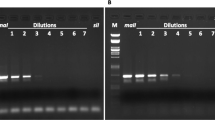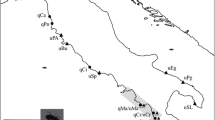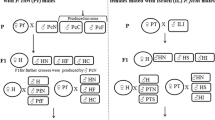Abstract
Strict maternal inheritance of mitochondrial (mt) DNA is believed to be the rule in most eukaryotic organisms because of exclusion of paternal mitochondria from the egg cytoplasm during fertilization. In honeybees, polyspermic fertilization occurs, and many spermatozoa, including their mitochondria-rich flagellum, can completely penetrate the egg, thus allowing for a possibly high paternal leakage. In order to identify paternal mtDNA in honeybee eggs, restriction fragment length polymorphisms (RFLP) of different subspecies were used. Total DNA extracts of different developmental stages of an Apis mellifera carnica x Apis mellifera capensis hybrid brood were tested with a radioactively-labelled diagnostic mtDNA probe. Densitograms of autoradiographs indicated that the male contribution represents up to 27% of the total mitochondrial DNA in the fertilized eggs 12 h after oviposition. In subsequent developmental stages the portion of paternal mtDNA slowly decreased until hatching of the larvae when only traces were found. Although rapid disintegration of paternal mtDNA does not occur, the initially high paternal mitochondrial contribution is not maintained in the adult animal.
Similar content being viewed by others
References
Adam A (1912) Zool Jb Anat Abt 35:1–74
Anderson WA (1968) J Ultrastructure Res 24:311–321
Balinsky BI (1975) Annu Rev Genet 12:471–512
Birky CW Jr, Acton AR, Dietrich R, Carver M (1982) Mitochondrial transmission genetics: replication, recombination, and segregation of mitochondrial DNA and its inheritance in crosses. In: Slonimski P, Borst P, Attardi G (eds) Mitochondrial genes. Cold Spring Harbor Laboratory, Cold Spring Harbor, New York, pp 333–348
Blochmann F (1889) Morphol Jb 15:85–96
Bretschneider LH (1948) L Proc Kon Ned Acad Wetensch 51:616–626
Brown JR, Beckenbach AT, Smith MJ (1992) Genetics 132:221–228
Chapman RW, Stephens JC, Lansman RA, Avise JC (1982) Genet Res 40:41–57
Cornuet J-M, Garnery L, Solignac M (1991) Genetics 128:393–403
Counce SJ (1973) The causal analysis of insect embryogenesis. In: Counce SJ, Waddington CH (eds) Developmental systems: Insects, vol. 2. Academic Press, New York, pp 1–156
Crozier RH, Crozier YC, Mackinlay AG (1989) Mol Biol Evol 6(4):399–411
Davey KG (1965) Reproduction in the insects. Oliver and Boyd, Edinburgh, London
Dawid IB (1966) Proc Natl Acad Sci USA 56:269–276
Dawid IB, Blackler AW (1972) Dev Biol 29:152–161
Drescher W, Rothenbuhler WC (1963) J Hered 54:194–201
Friedländer M (1980) Int J Insect Morph Embryol 9:53–57
Gyllenstein U, Wharton D, Wilson AC (1985) J Hered 76:321–324
Gyllenstein U, Wharton D, Josefsson A, Wilson AC (1991) Nature 352:255–257
Hall HG, Muralidharan K (1989) Nature 339:211–213
Hamilton HH (1952) Lillie's Development of the chick. Holt, New York
Hennig W (1988) Spermatogenesis in Drosophila. In: Malacinski GM (ed) Developmental genetics of higher organisms. Macmillan, New York, pp 239–274
Hilderth PE, Lucchesi JC (1963) Fertilization in Drosophila. Dev Biol 6:262–278
Hoeh WR, Blakley KH, Brown WM (1991) Science 251:1488–1490
Kawano S, Takano H, Mori K, Kuroiwa T (1991) Protoplasma 160:167–169
Kondo R, Satta Y, Matsuura ET, Ishiwa H, Takahata N, Chigusa SI (1990) Genetics 126:657–663
Kondo R, Matsuura ET, Chigusa SI (1992) Genet Res 59:81–84
Laidlaw HH, Tucker KW (1964) Genetics 50:1439–1442
Lansman RA, Avise JC, Huettel MD (1983) Proc Natl Acad Sci USA 80:1969–1971
Maniatis T, Fritsch EF, Sambrook J (1982) Molecular cloning: a laboratory manual. Cold Spring Harbor Laboratory, Cold Spring Harbor, New York
Meland S, Johansen S, Johansen T, Haugli K, Haugli F (1991) Curr Genet 19:55–60
Meusel MS, Moritz RFA (1992) Apidologie 23:147–150
Moritz RFA, Meusel MS (1989) Proc 32nd Int Cong Apimondia, Rio de Janeiro
Moritz RFA, Hawkins CF, Crozier RH, Mackinlay AG (1985) Experientia 42:322–324
Nachtsheim H (1914) Arch Zellforsch 2:169–241
Neale DB, Marshall KA, Sederoff RR (1989) Proc Natl Acad Sci USA 86:9347–9349
Petrunkewitsch A (1901) Zool Jb 14:573–608
Piko L, Matsumoto L (1976) Dev Biol 49:1–10
Richards AG, Miller A (1937) J New York Ent Soc 45:1–60
Rothenbuhler WC (1957) J Hered 48:160–168
Rothenbuhler WC, Gowen JW, Park OW, (1952) Science 115:637–638
Rothschild L (1956) Fertilization. Methuen and Co. Ltd, London
Satta Y, Toyohara N, Ohtaka C, Tatsuno Y, Watanabe TK, Matsuura ET, Chigusa SI, Takahata N (1988) Genet Res 52:1–6
Sheppard WS, Rinderer TE, Mazzoli JA, Stelzer JA, Shimanuki H (1991) Nature 349:782–784
Smith DR (1988) Mitochondrial DNA polymorphisms in five Old World subspecies of honey bees and in New World hybrids. In: Needham GR, Page RE, Delfinado-Baker M, Bowman CE (eds) Africanized honey bees and bee mites. Ellis Horwood, Chichester, pp 303–312
Smith DR, Brown WM (1988) Experientia 44:257–260
Smith DR, Taylor OR, Brown WM (1989) Nature 339:213–215
Southern EM (1975) J Mol Biol 98:503–517
Stordeur E de, Solignac M, Monnerot M, Mounolou JC (1990) Mol Gen Genet 220:127–132
Takahata N, Maruyama T (1981) Genet Res 37:291–302
Takahata N, Palumbi SR (1985) Genetics 109:441–457
Vlasak I, Burgschwaiger S, Kreil G (1987) Nucleic Acids Res 15:2388
Wilson AC, Cann RL, Carr SM, George M, Gyllenstein UB, Helm-Bychowski KM, Higuchi RG, Palumbi SR, Prager EM, Sage RD, Stoneking M (1985) Biol J Linn Soc 26:375–400
Zouros E, Freeman KR, Oberhauser Ball A, Pogson GH (1992) Nature 359:412–414.
Author information
Authors and Affiliations
Additional information
Communicated by C. W. Birky Jr.
Rights and permissions
About this article
Cite this article
Meusel, M.S., Moritz, R.F.A. Transfer of paternal mitochondrial DNA during fertilization of honeybee (Apis mellifera L.) eggs. Curr Genet 24, 539–543 (1993). https://doi.org/10.1007/BF00351719
Received:
Accepted:
Issue Date:
DOI: https://doi.org/10.1007/BF00351719




